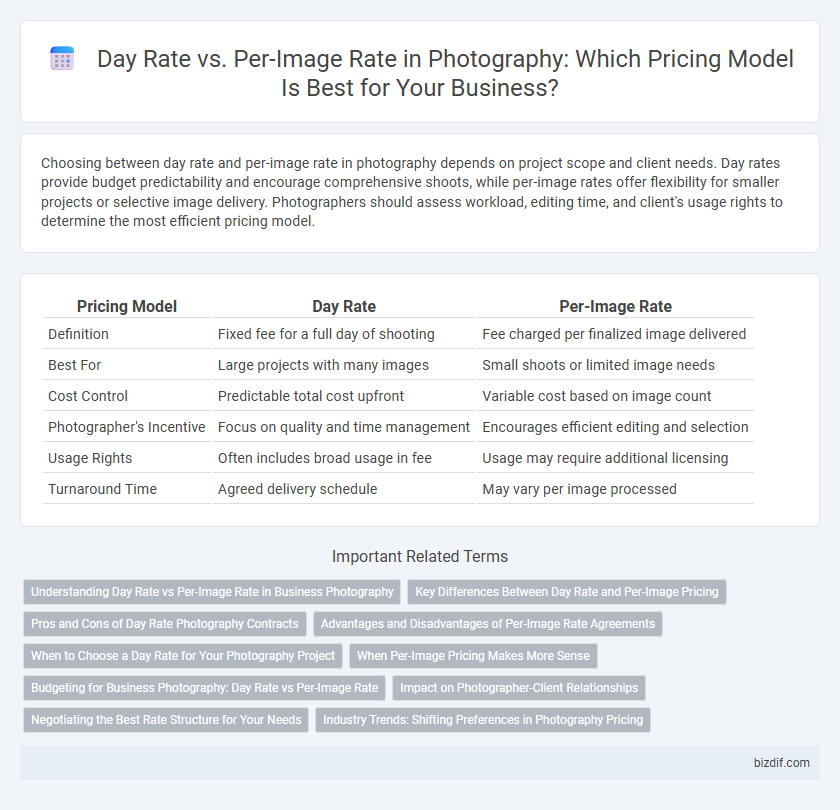Choosing between day rate and per-image rate in photography depends on project scope and client needs. Day rates provide budget predictability and encourage comprehensive shoots, while per-image rates offer flexibility for smaller projects or selective image delivery. Photographers should assess workload, editing time, and client's usage rights to determine the most efficient pricing model.
Table of Comparison
| Pricing Model | Day Rate | Per-Image Rate |
|---|---|---|
| Definition | Fixed fee for a full day of shooting | Fee charged per finalized image delivered |
| Best For | Large projects with many images | Small shoots or limited image needs |
| Cost Control | Predictable total cost upfront | Variable cost based on image count |
| Photographer's Incentive | Focus on quality and time management | Encourages efficient editing and selection |
| Usage Rights | Often includes broad usage in fee | Usage may require additional licensing |
| Turnaround Time | Agreed delivery schedule | May vary per image processed |
Understanding Day Rate vs Per-Image Rate in Business Photography
Day rate pricing in business photography involves charging a fixed fee for a full day of shooting, offering predictability and coverage for extensive projects or multiple setups. Per-image rate pricing charges clients based on the number of final edited photos delivered, ideal for projects needing specific images without prolonged studio time. Understanding these models helps photographers balance workload, client expectations, and revenue, optimizing profitability for each business photography assignment.
Key Differences Between Day Rate and Per-Image Pricing
Day rate pricing in photography charges a flat fee for a full day's work, covering shoot time, setup, and basic editing, whereas per-image pricing bills clients based on the number of final edited photos delivered. Key differences include cost predictability, with day rates offering a fixed budget and per-image rates providing flexibility according to usage or project scale. Photographers often choose day rates for commercial shoots requiring multiple images, while per-image pricing suits projects needing select high-quality photos or varying post-production efforts.
Pros and Cons of Day Rate Photography Contracts
Day rate photography contracts offer consistent income and simplify budgeting by charging a fixed fee regardless of the number of photos taken, benefiting photographers working on large or unpredictable shoots. However, they may limit potential earnings when fewer images are delivered, as payment does not scale with output, potentially undervaluing photographers on efficient sessions. Clients appreciate day rates for predictable costs, but such contracts may reduce flexibility in post-production and image selection compared to per-image rate agreements.
Advantages and Disadvantages of Per-Image Rate Agreements
Per-image rate agreements provide precise cost control by charging clients only for selected photos, reducing unnecessary expenses compared to flat day rates. This model incentivizes photographers to deliver high-quality, impactful images but can lead to unpredictable income and increased administrative workload due to tracking individual image usage. However, per-image rates may limit creative freedom as photographers might focus solely on images likely to be sold rather than capturing diverse or experimental shots.
When to Choose a Day Rate for Your Photography Project
Choosing a day rate for your photography project is ideal when the scope demands extended hours, multiple locations, or extensive setup time that exceeds a few images. Day rates simplify budgeting for clients by covering unlimited images and post-processing within the agreed timeframe, often yielding better value for complex shoots. This pricing model benefits clients with flexible or evolving creative needs, ensuring comprehensive coverage without incremental per-image charges.
When Per-Image Pricing Makes More Sense
Per-image pricing makes more sense for photography projects with a limited number of specific shots, ensuring precise cost control and clear deliverables. This model benefits clients who require high-quality edits or retouching on each photograph rather than an extended shoot duration. It also suits photographers specializing in commercial or product photography, where every image's value directly correlates with its usage and final output.
Budgeting for Business Photography: Day Rate vs Per-Image Rate
Budgeting for business photography requires understanding the differences between day rates and per-image rates to optimize value and control costs. Day rates offer predictable pricing for extensive shoots, ideal for projects needing multiple images, while per-image rates provide flexibility by charging only for the final deliverables, benefiting clients with limited needs. Choosing the right model depends on project scope, desired image quantity, and overall budget constraints, ensuring efficient allocation of resources.
Impact on Photographer-Client Relationships
Day rate pricing fosters stronger photographer-client relationships by providing predictable costs and streamlining project planning, enhancing trust and collaboration. Per-image rate structures can create tension when clients focus on quantity over quality, potentially compromising creativity and communication. Transparent discussions about pricing models empower both parties to align expectations and cultivate long-term partnerships.
Negotiating the Best Rate Structure for Your Needs
Negotiating the best rate structure for photography requires understanding the differences between day rate and per-image rate models, as day rates offer predictable costs for extended shoots while per-image rates provide flexibility based on project scope. Consider factors like shoot duration, post-processing time, and usage rights to determine which pricing aligns with your budget and intended use. Effective negotiation involves clarifying deliverables and rights to avoid unexpected expenses and ensure maximum value from your photography investment.
Industry Trends: Shifting Preferences in Photography Pricing
Photography industry trends reveal a growing shift from traditional per-image rates to day rate pricing, driven by clients seeking streamlined budgeting and predictable costs. Day rates offer photographers consistent income and simplify contract negotiations, especially for event and commercial shoots requiring varied image outputs. This evolving preference reflects a broader move toward flexible, value-based pricing models that accommodate diverse project scopes and faster delivery expectations.
Day Rate vs Per-Image Rate Infographic

 bizdif.com
bizdif.com